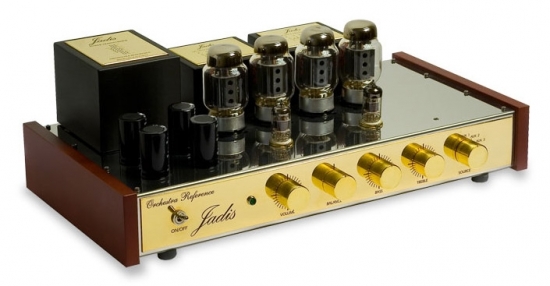Amplifier Jadis Orchestra Reference
Bearing chassis is made of polished stainless steel, gilded bezel with black scales, machined handle - all in perfect harmony with wooden side panels. Even black shrouds transformers - network and two weekends - decorated with golden polished plates.
Judging by the number of lamps, circuit Orchestra Reference laconically. Cascade preamp and driver built on the half dual triode 12AX7/ECC83. The origin of the lamp initially puzzled: under the logo Tung-Sol showed a smaller inscription - "Made in Russia". Climbed into the Internet and found out that this American brand, first announced itself in 1907, is now owned by the holding company New Sensor Corporation, which also owns brands Russian Sovtek and Electro-Harmonix.
In the final stages of work pentode Electro-Harmonix KT90 ultralinear in turn and, it seems, is very close to the class A - in diffusion at the anode of each lamp 50 W power amplifier declared all 40 On request, instead of KT90 can also be set tetrodes EL34, 6550 and KT88. What is interesting, output transformers have taps for acoustics with different resistance, and the range of permissible load marked from 1 to 16 ohms. Typically, the final stage is calculated for quite some importance, or otherwise increase the distortion, or power output drops. Operational calibration lamps are not available, at their replacement is necessary to remove the bottom of the amplifier and set the quiescent current with a multimeter.
The amplifier can be connected to up to five line-level sources and one recorder.
All transformers, according to the form of screens, wound on a EI-cores of large cross section. Amplifier is hand-assembled in France by surface mounting, only some parts of the circuit are mounted on a small printed circuit boards. To filter the anode voltage of the capacitor, four SIC-SAFCO 1000 uF x 350 V. And other accessories at: ceramic tube sockets and gold plated connectors - RCA input and speaker WBT.
In addition to Reference, there are also two versions of this model: just Orchestra without TONE and Orchestra DIP with a white front panel and a landing pad for the iPod.
To finally get into the voice amplifier need to warm up for about an hour.
Despite the fact that our speakers Monitor Audio Gold Reference 20 is clearly aimed at the transistor gain, any problems with the agreement have arisen. Sharp dynamic peaks in the recording Symphony Orchestra did not cause any problems - color or the audible compression somehow not felt. When only a powerful pressure and dense spectrum of symphonic works are not shipped hearing, there was no side effects in the form of coloring or excessive contrast inherent in most transistor amplifiers. The only thing that was immediately noticeable - the lack of infra-low component, without which the orchestra acquired uncharacteristic lightness, simplified and atmosphere of the hall, lost his "breath". It managed to tweak the tone control bass, but only partially.
To describe the rest of you can feel free to use superlatives. So competent pentode scheme that combines crushing dynamics inherent powerful transistor stages, with the openness and comfort directly heated triode, is extremely rare. Hence the unusual sensations: tutti to expect a heavy blow to the ears, but instead - a well-coordinated operation of the orchestra, in which separate groups of instruments can be heard. Violin not cut the ear, but not blurry, to completely live sound to them just a little bit lacking corporeality in the lowest octave.
The upper range of light, air, without the veil. In this area, the atmosphere is perfectly formed, it mass harmonic nuances. Acoustic instruments in chamber music compositions it is almost impossible to distinguish from the real ones. Gorgeous nuances lets hear any detail, but the attention is focused on them. Mid "with velvet", with an enormous amount of timbral colors.
The scene is built without any significant simplifications in some phonograms seems that some tools go almost two meters behind the speakers. Plates are not tied to tweeters, they are located in virtually the same place where the entire drum kit.
In general, the power is quite intelligent, with a good understanding of music and no obvious genre preferences. And it is absolutely modern, able to show the speed and dynamics, even with a very difficult acoustics.




